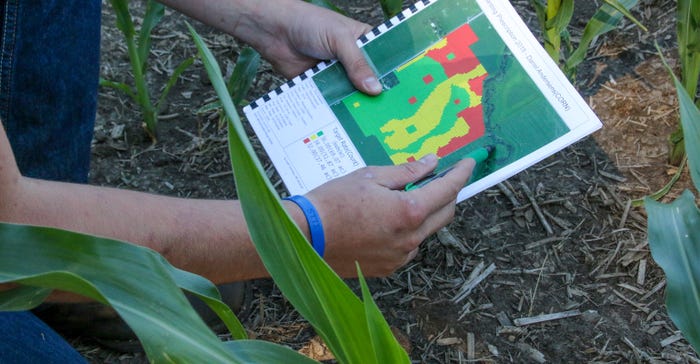
You’ll be hearing more about the 4R Plus program, launched earlier this year in Iowa. A coalition of agriculture and conservation stakeholders has joined together to raise awareness about practices farmers can use to improve soil health and productivity, reduce erosion and runoff, and protect water quality.
The 4R’s of nutrient stewardship — applying the right source of fertilizer at the right rate and right time, and in the right place — aren’t new. These guidelines have been around awhile. The “Plus” has now been added to include soil conservation and water quality practices. The combination can increase yield and efficiency while protecting the environment.
“Using 4R Plus practices goes beyond on-farm sustainability benefits,” says Greg Wandrey, Iowa agriculture program manager for The Nature Conservancy and coordinator of the 4R Plus program. “4R Plus can also improve production and farmer profitability.”
Providing resources, information
The Nature Conservancy, along with fertilizer manufacturer CF Industries, unveiled the 4R Plus program last winter at the annual meeting of the Agribusiness Association of Iowa (AAI), an organization that includes the state’s fertilizer and chemical dealers, certified crop advisers and related ag businesses.
4R Plus is a nutrient management and conservation education effort to equip farmers and their advisers with resources and information to protect and enhance soils, Wandrey says. It brings agriculture and conservation together to deliver a consistent set of messages around conservation practices. Support for the program has expanded to include more than 30 collaborators: state commodity groups, agribusinesses, conservation organizations, government agencies, Iowa State University and others.
“We all have the same goal,” says Tony Will, CEO of CF Industries. “That is, to build upon the good work farmers are doing and provide them with more tools and resources to help implement practices that enhance crop growth and boost yield potential and return on investment, while safeguarding some of the best soil in the world.”
Keeping soil healthy important
The Fertilizer Institute for many years has encouraged fertilizer dealers and crop advisers to use the 4R approach to nutrient management, says Shawn Richmond, environmental technology director for AAI. “Using 4R stewardship practices is a way for farmers to manage nutrients to meet a crop’s needs while minimizing nutrient losses from the field,” he adds. “The 4R Plus approach takes the 4R effort a step further with the use of conservation and soil health practices.”
Whether it’s the nutrient source, rate, time or place, farmers must make nutrient decisions based on information specific to their farm, soil characteristics and operational logistics. Farmers are encouraged to work with their advisers to select specific 4R practices to optimize fertilizer inputs for their individual operations. Improving soil health is an added benefit.
Reducing nutrient loss from fields
Using 4R Plus guidelines to reduce nutrient loss is more important than ever. With the Iowa Nutrient Reduction Strategy’s goal to reduce nitrate and phosphorous loads in Iowa waters by 45%, farmers are looking for workable ways that can help. Conservation practices help retain moisture, soil and nutrients, and reduce erosion and runoff resulting in healthier soil and cleaner water. These practices are even more effective when targeted in areas that have greatest runoff, nutrient loss and soil loss.

NEW TOOLS: Using digital photos and field maps, Eric Andersen can spot problems in his fields, such as where crop nutrient deficiency, disease or soil compaction is occurring.

“Iowa’s Nutrient Reduction Strategy is based on scientific studies,” Richmond says. “It shows that using in-field practices such as no-till, strip till and cover crops will get us part way toward meeting the state’s goal for 45% reduction in phosphorous and nitrate in Iowa streams, rivers and lakes. To achieve the total goal, we will need to use the other Plus practices, too, such as terraces and grass waterways, and edge-of-field practices like wetlands, saturated buffers and bioreactors.”
Marty Adkins, assistant state conservationist for USDA Natural Resources Conservation Service in Iowa, a 4R Plus collaborator, sees the need for farmer resources and information on how to best choose and use conservation practices.
Conservation practices help
“There’s a natural link between sound nutrient management and conservation practices resulting in better soil health, water quality and farmer profitability,” Adkins says. “NRCS is pleased to work with other organizations to help farmers and agronomists better understand soil health, why healthy soil is important, and how it can be achieved.”
A good first step is to develop a conservation plan. “These plans help farmers see where they stand now and what conservation practices they need to consider,” he says. “A conservation plan can also help you access farm programs, which can help pay the cost of installing conservation practices.”
Depending on the farm, there are a variety of conservation practices available. No-till, strip till and cover crops are in-field practices that minimize soil erosion and improve water infiltration, while stream buffers and wetlands act as edge-of-field filters for surface and tile water.
Growing effort, on and off farm
“It takes everyone working together to help farmers achieve economic, agronomic and environmental success. Finding the right 4R Plus practices for a field or farm is critical,” Wandrey says.
He adds, “The purpose of bringing the stakeholders together, and ultimately the purpose of the 4R Plus program, is to provide consistent messages about 4R nutrient stewardship and conservation practices. Farmers and crop advisers can work together to adopt practices to help achieve positive results. Iowa farmers are growing food, fiber and fuel on over 23 million acres. Change happens on an individual level, but if we take an all-hands-on-deck approach to nutrient stewardship and conservation practices, think of the significant results we will see.”
To learn more about 4R Plus and resources available to get started, visit 4rplus.org.
About the Author(s)
You May Also Like




